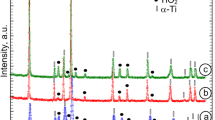Conclusions
-
1.
Titanium specimens, of 30% porosity, prepared from an electrolytic powder of the −1 +0.25 mm fraction exhibit low corrosion resistance in 40%H2SO4 and 20%HCl solutions at room temperature. Specimens nitrided at 850°C for 30 min differ only little in this respect from specimens which have not been nitrided.
-
2.
The nitriding of such specimens for 8 h at 850°C substantially increases their resistance to corrosion by 20% HCl. After 600 h of testing, the electrical resistivity of the specimens rises only negligibly and their surface remains bright. The corrosion resistance of such specimens in 40% H2SO4 is essentially no different from that of specimens from pure titanium.
-
3.
The surface alloying of titanium powder with 2, 0.2, and 0.1% palladium, performed from a PdCl2 solution, passivates specimens prepared from such powder in 20% HCl, as a result of which they resist corrosion in this acid at room temperature and holding periods of up to 600 h. Specimens containing 0.05% palladium begin to corrode after 400 h of holding in this acid. In 40% H2SO4, passivity of specimens is attained by introducing 2 or 0.2 wt.% palladium into titanium powder. Decreasing the palladium addition to 0.1 or or 0.05 wt.% lowers the corrosion resistance of titanium specimens.
-
4.
Specimens of all the porous titanium materials investigated are totally immune to corrosion in 30% caustic soda solutions.
Similar content being viewed by others
Literature cited
K. Mauer, H. Grewe, and H. Weigand, DEW Tech. Ber.,6, No. 3, 115 (1966).
Yu. V. Grdina, L. T. Gordeeva, and L. G. Timonina, Izv. Vysshikh Uchebn. Zavedenii, Chernaya Met., No. 6, 128 (1962).
V. N. Eremenko, Titanium and Its Alloys [in Russian], Izd-vo AN UKr.SSR, Kiev (1960), p. 212.
N. D. Tomashov and R. M. Al'tovskii, Corrosion and Protection of Titanium [in Russian], Moscow (1963), p. 125.
N. D. Tomashov, M. N. Shulyapnikov, and Yu, M. Ivanov, Zashchita Metal.,1, 122 (1965).
N. D. Tomashov, R. M. Al'tovskii, et al., in; Corrosion and Protection of Constructional Materials [in Russian], edited by N. D. Tomashov, Mashgiz (1961), p. 151.
V. V. Andreeva and E. A. Yakovleva, in: Corrosion and Protection of Constructional Alloys [in Russian], edited by A. I. Golubev, Izd-vo “Nauka,” Moscow (1966).
Author information
Authors and Affiliations
Additional information
Translated from Poroshkovaya Metallurgiya, No, 12 (72), pp. 59–64, December, 1968.
Rights and permissions
About this article
Cite this article
Arensburger, D.S., Pugin, V.S. & Fedorchenko, I.M. Corrosion resistance of porous titanium in some aggressive media. Powder Metall Met Ceram 7, 977–981 (1968). https://doi.org/10.1007/BF00773435
Received:
Issue Date:
DOI: https://doi.org/10.1007/BF00773435




